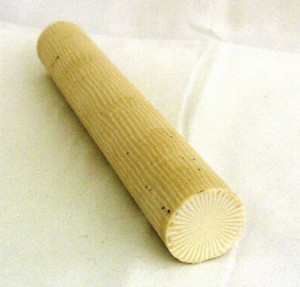 We’ve been testing a “new” old ivory alternative called “casein”.
We’ve been testing a “new” old ivory alternative called “casein”.
This is a plastic made from milk. You’ll find many DIY articles on the net and usually people say “meh.” when they’re finally done, but this was a common alternative at the turn of the last century through about the 1970’s in western Europe. We were able to get a couple of samples from “across the pond” and it’s quite interesting. Extremely dense, polishes beautifully and doesn’t “crater” like typical plastics. We got our samples as rods, mostly used to cut buttons or to turn on a lathe, and went about cutting medallions. It took a long time to cut through it, and the dust is awful – it stays airborne a long time and due to the way it’s made, you’ll definitely want to upgrade your dust masks. Plain casein plastic is made from milk as stated. In order to make it resilient casein is subjected to a formaldehyde bath for up to one year depending on the thickness where the formaldehyde molecules bind with the casein making it harder and more resilient.
The casein is finally rinsed and dried, most of the harmful chemical leaving the end product by off-gassing and repeated rinsing. Ford at one point had experimented making a “plastic car” substituting casein based plastics with soybean and hemp based plastics (see “Henry’s Hobbies“, pg 283).
By the looks of http://pubs.acs.org/doi/abs/10.1021/ie50459a024 the amount of formaldehyde would be negligible for normal handling, but there are no MSDS for this material available that we’ve been able to find, so it is far better to be safe than sorry.
They still make casein plastic knitting needles, and it’s supposed to be some of the finest knitting needles available.
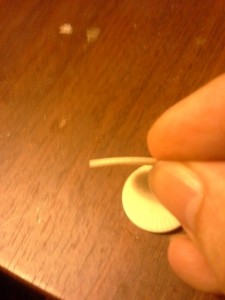
Instead of formaldehyde, companies are creating casein plastic successfully using “glyceraldehyde” which is not considered harmful by OSHA (see http://datasheets.scbt.com/sc-300881.pdf).
We’re probably not going to see this material processed either by formaldehyde or glyceraldehyde any time soon because it can take up to one year for it to be ready, but our source for the casein we’ve been working with is listed at the end.
As stated, casein itself only takes a day or so to make and dry, but it does have to soak for a long time in the fluid for it to permeate completely. Any DIY’ers out there may be able to make a small side business offering cabachons or possibly knife scales provided the total thickness is less than 1/2″ If you look around etsy you can see a lot of vintage casein buttons as well as other useful items that were once made from this material (see Instructibles for the one of many articles on creating your own plastic).
We’ve also come across an “alternative casein” available for turning and possibly for scrimshaw but we haven’t purchased any yet, and are unsure what the “alternative” is: whether it’s an acrylic or polyester made to look like casein or if it’s a “green” casein made from glyceraldehyde. It’s available from “Exotic Blanks” .
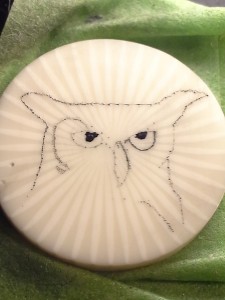 So how well does it scrim? It works great for both line scribing and for stippling. The only problem we found with our samples were small air holes in the faces we’d cut. These would vary from few to numerous, most of them very small and could be incorporated into the scrimshaw design or a “squirt and fill” may also work using a cyanoacrylate glue (crazy glue) and some of the powder from cutting which is a popular way to fill voids in other materials. We found our best piece and scrimmed an owl which you can see in progress. We followed tried coloring the back of the template and piercing the paper once it was secured and it worked quite well.
So how well does it scrim? It works great for both line scribing and for stippling. The only problem we found with our samples were small air holes in the faces we’d cut. These would vary from few to numerous, most of them very small and could be incorporated into the scrimshaw design or a “squirt and fill” may also work using a cyanoacrylate glue (crazy glue) and some of the powder from cutting which is a popular way to fill voids in other materials. We found our best piece and scrimmed an owl which you can see in progress. We followed tried coloring the back of the template and piercing the paper once it was secured and it worked quite well.
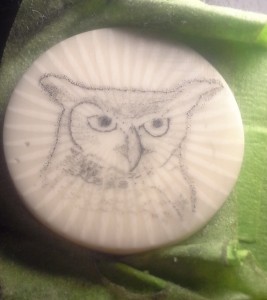 Most of the owl is done in the stipple technique, though we tried a few lines going “dot-to-dot” on the upper right hand side of the owl’s head. Very little cratering, and the material holds both ink and aquarelle black pencil well.
Most of the owl is done in the stipple technique, though we tried a few lines going “dot-to-dot” on the upper right hand side of the owl’s head. Very little cratering, and the material holds both ink and aquarelle black pencil well.
We’d like to find this material in sheet form at 3/16″ thickness, and if you come across a supplier, please let us know.
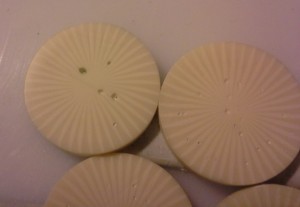
Casein in rod form is available from http://www.johnberkeley.biz/page15.html
Further reading on Casein Formaldehyde: Green Plastics: An Introduction to the New Science of Biodegradable Plastics
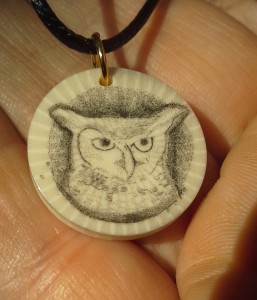
Hi, I am in the U.S. and am interested in acquiring small quantities of casein for a project I’m working on. I found you in a general Goog,le search. Could I ask where you are buying your casein? I have found one source in the UK and one in Germany, but am always looking for others. Thanks so much, and Happy New Year
Hi Scott, and happy 2016! The sources I use are in the UK and can be found here: https://www.scrimshaw.com/casein-ivory-alternative/. They’re good to work with, and I’m curious about their other offerings but haven’t had a chance to order any. Let me know how much you need, I may be able to supply you with some for your project in raw or cut form.